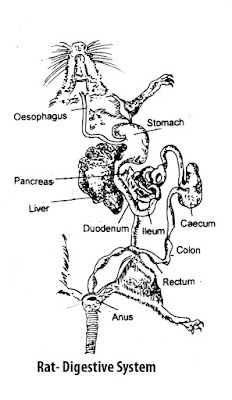Practical
Course in Zoology for B.Sc.II As per Solapur University.
Practical – II
I. Taxonomy-
Classification with morphological peculiarities of the
following up to orders:
i) Reptiles – Turtle, Tortoise, Chamaeleon, Garden lizard,
Crocodile
ii) Aves – Duck, Kite, Woodpecker, Sparrow, Sunbird,
Vulture, Kingfisher Fowl.
iii) Mammals - Platypus, Bat, Scaly ant eater, Loris, Rabbit
(Models/Photographs/Sketches)
II. Study of Rat
: Anatomical observation and detailed
explanation of the following system with CD/Model/Chart of
i) Digestive system
ii) Respiratory system
iii) Arterial system
iv) Venous system
v) Excretory system
vi) Reproductive systems (Male and Female)
III. Anatomical observation and detailed
explanation of brain of bird with
CD/Model/Chart-
IV. Observation and detail explanation of
following with CD/Slide/Model/Charti)
Blood of mammal ii) Pecten of bird iii) Sclerotic plate of
bird
iv) Collumela of bird v) Hyoid apparatus of bird
V. Study of Mesozoic reptiles (using
chart/models/CD)
VI. Identification of the following
poisonous and non poisonous snakes using laboratory specimens
i) Cobra ii) Russel’s Viper iii) Indian little Viper
(Phoorsa) iv) Krait v) Sea snake
vi) Rat snake vii) Sand boa
VII. Study of Beak and leg modification in
birds using laboratory specimens
i) Parrot ii) Woodpecker iii) Heron iv) Duck v)
Sparrow/Pigeon vi) Hawk/Kite
viii) Owl ix) Vulture
VIII. Study of dentition in mammals using
laboratory materials/models/CD of:
Sheep, Rat, Rabbit, Dog, Man
IX. Study of histological structure
(T.S./V.S.) of the following mammalian organs using spermanens, slides:
i) Tooth ii) Salivary gland iii) Oesophagus iv) Stomach v)
IIeum vi) Rectum vii)Liver viii) Pancreas ix) Kidney x) Testis xi) Ovary xii)
Uterus xiii) Pituitary gland xiv) Spinal cord
X. Study of Rat sperm and vaginal smear
using CD/Chart/Permanent slides
XI. Study of following abnormal urine
constituents: Glucose, Bile, Blood and Albumin
XII. Study of ABO blood group system and
blood group antigens
XIII. Study of following contraceptives: Oral
contraceptives (pills), Intra-uterine device, Condom using chart/photographs.
Excursion Tour :
Six days tour is recommended
As a part of practical, visit to sea-shore/any suitable
place of Zoological interest (Visit to sea-shore, Fishery Centers, National
Parks, Wildlife Sanctuaries, National Research Institutes, Central Research
Institutes, Zoological Survey of India, Fresh Water Ecosystem etc. to study
animal diversity and economic Zoology. A report is to be submitted at the time of
Practical examination.








